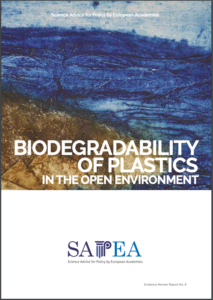 This year has already seen quite an impressive number of studies, reports, and additional publications related to bioplastics that were published by the European Commission (EC). Most of them contribute to the development of a framework for bioplastics included in the EC’s Circular Economy Action Plan. For the bioplastics industry, a clear framework is paramount to ensure reliability in decision-making.
This year has already seen quite an impressive number of studies, reports, and additional publications related to bioplastics that were published by the European Commission (EC). Most of them contribute to the development of a framework for bioplastics included in the EC’s Circular Economy Action Plan. For the bioplastics industry, a clear framework is paramount to ensure reliability in decision-making.
This week (14 December), the European Commission’s Scientific Advice Mechanism (SAM) published the long-awaited report “Biodegradability of plastics in the open environment”. It identifies applications of biodegradable polymers which contribute towards achieving a circular economy and tackle the challenge of managing the EU’s waste. The report is an important element in the process towards the development of the framework. “We are pleased to see that this report clearly identifies several beneficial application areas for biodegradable plastics even though this was not its original focus”, says Hasso von Pogrell, Managing Director of European Bioplastics (EUBP). “We also welcome the call for economic incentives to promote appropriate disposal behaviour as well as the need for further research that it highlights”, he adds.
The SAM report emphasises the advantages of applications from biodegradable plastics “where it is challenging to remove or collect a particular plastic product or its fragments from the environment after use”. Mulch films made from conventional plastics, for example, are widely used in European agriculture. The challenge of plastic accumulation in soil can be tackled with the soil-biodegradable alternative. In its conclusion the report also highlights the benefits of biodegradable plastic products “where it is difficult to separate plastic from organic material that is destined for a composting waste stream or wastewater treatment”. Packaging highly contaminated with food scraps, cannot be mechanically recycled and will be incinerated or, even worse, landfilled. By using industrial compostable packaging, this contaminated waste fraction will not get lost as it can be included in the organic recycling stream. Additionally, it has been proven in several studies that industrially compostable biowaste bags significantly increase the capture rate of biowaste.
However, one has to agree with the study’s authors that the benefits of biodegradable plastics require that the formulation of the product is appropriate to the receiving environment, and if any potential for the item or its fragments to escape to a receiving environment in which it biodegrades more slowly, is minimised. At the same time, it is also important to highlight the report’s statement for an effective waste management infrastructure to assure proper management of biodegradable and compostable plastics. “Industrially compostable plastics will become increasingly relevant in this context, as the EU’s objective of diverting organic waste from landfill by end of 2023 approaches”, adds the Managing Director of EUBP.
There is no doubt that a successful reduction of plastic waste and achieving a circular economy requires ongoing efforts by all parts of the value chain, also including consumers, and national and regional authorities. “If we are to realise the full potential of biodegradable plastics, the EU must put in place supportive measures to improve labelling, uphold and periodically review certification and standards, and facilitate communication on waste management. Consumers are seeking out sustainability more and more. However, they need to be helped with the challenges of delivering a circular economy through more effective waste prevention, recycling and management measures including through organic recycling. European Bioplastics stands ready to support in this endeavour”, concludes Hasso von Pogrell.